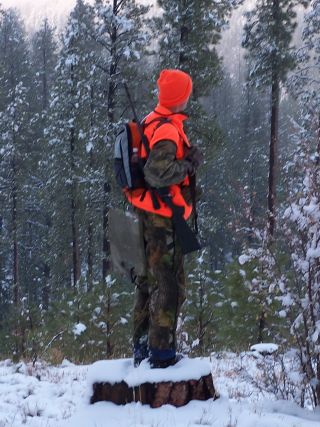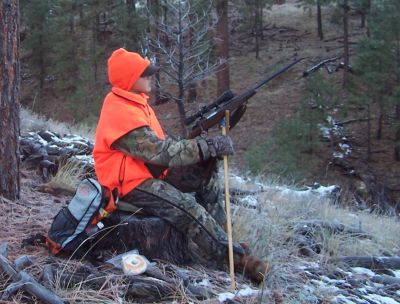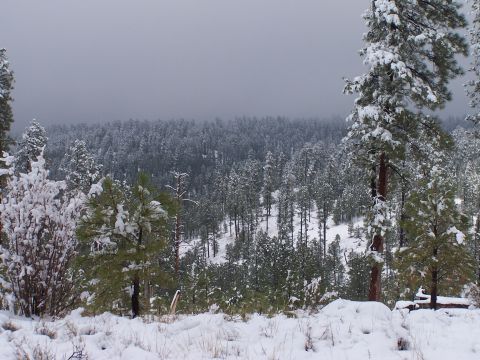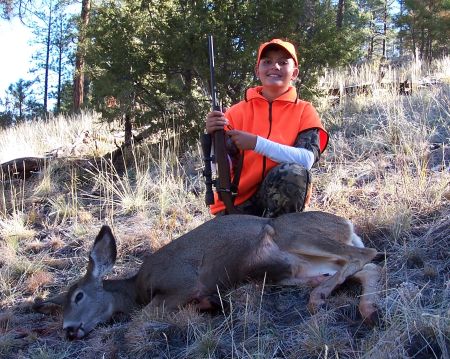
| Articles | Documents | Equipment | Events | Links | Membership | Miscellaneous | Scrapbook | Targets | What's New |
|
Kaibab Kids
| November 2004 | ||||
| Dan Martinez
| |||||
|
I didn’t draw an Arizona deer tag this year, but my
kids did. The boys, Ben, age 13, and Sam, age 10, decided that
they wanted to apply for the Unit 12A-West juniors-only doe hunt
this year, and they drew tags. The hunt was scheduled for four
days, October 22nd through October 25th. 500 tags for antlerless
mule deer were allocated. I think I was more jazzed that they
drew than they themselves were.
Choosing Rifles and Finding Loads
Familiarization and shooting practice started not long after draw
notification. One problem quickly became apparent for Ben with
the .243. For me, the .243 has been filling the role of a “walking
varminter”. I had a 4-16x42mm Tasco trajectory-rangefinding,
adjustable-objective scope mounted on it. The scope has two
horizontal crosswires for range measurement purposes. The
finger-adjustable elevation turret is exposed so it can be quickly
dialed-in for long-range trajectory compensation. This scope
is way too complicated for a kid on his first deer hunt. For the
kid, it’s way too easy to accidentally knock the scope off zero.
I replaced the scope with a new basic 3-9x38mm Weaver.
I had experienced some inconsistent pressure problems trying to come
up with a full-power 100 grain deer load for this .243, so I quit
trying. I had resigned myself to sticking with mid-pressure 80 grain
varmint loads for this rifle. But now, I was again challenged to
create a deer load. At least it didn’t have to knock down a massive
buck. I decided to to use the 90 grain Nosler Ballistic Tip as a
compromise between the 80 grain varmint bullets and the 100 grain
game bullets I had experimented with previously.
Still, I didn’t want to push the pressure envelope, so the charge
I ended up with was 35.0 grains of IMR 4064, which still pushed the
90 grain pill out of the muzzle at around 2840 fps. Unfortunately,
I was still seeing very inconsistent velocities with this load too,
but by the time I got around to finding this out with the chronograph,
the deer season was upon us. 100 yard accuracy was fine, and since
the hunting would be short-range, I made the decision to go with it.
That muzzle-braked .243 is a real pussycat to shoot. The little
.260 Micro Hunter though, with a full power load, will get your
attention. Not that it is uncomfortable for a full-sized guy such
as you or me. However, recoil mitigation was a big factor in my
load development work for this rifle to be used by a 10-year-old.
But I still wanted it to hit hard enough to put a doe down for keeps.
I first got interested in the .260 Remington when I was looking for a
flat-shooting, hard-hitting, deer-capable caliber for long-range handgun
hunting. I acquired a .260 barreled action for my Magnum Research Lone
Eagle single-shot handgun. At full-power, the .260 is about the most
cartridge I want to shoot in a handgun. I soon developed a real sweet
reduced-power load for the Lone Eagle which is easily 95% of what I feed
it. It’s the Sierra 85 grain HP varmint bullet on top of 27.0 grains
of Accurate XMP 5744. This comes out of the Lone Eagle’s 14 inch barrel
at 2300 fps.
As sweet-shooting and accurate as this load is, I did not feel that
it was an appropriate deer load. But it does hold an important lesson
for recoil reduction. To effectively reduce recoil, you need to go
down not only in bullet weight, but also in powder weight.
A standard game load for the .260 Remington might be a bullet weighing
from 120 to 140 grains with as much as 45 to 48 grains of a slow-burning
powder. A quick recoil calculation based on the 7.1 pound scoped weight
of the Micro Hunter yields a recoil figure in the neighborhood of 14
foot-pounds.
But if we go down to a 100 grain bullet and use a mid-pressure charge
of a medium-burning powder, the recoil could be brought way down.
It would still be a real doe-killer, though. The final specs on Sam’s
.260 doe-load are the 100 grain Hornady softpoint on top of 35.0
grains of IMR 4064 yielding a velocity of 2600 fps in the Micro’s 20
inch barrel for only 8 foot-pounds of recoil.
Gerhard wrote last month about
his sweet little Remington Model 7 in 7mm-08. The Browning Micro Hunter
is a rifle cast from the same mold. A shorter-than-standard length barrel,
a shorter length of pull, a slimmer stock shape, and a short action frame
size make for a light, handy rifle usable by anyone from kids to ladies,
even big guys like me, but still quite capable of reaching out there with
power and accuracy. You don’t hang a big heavy scope on a trim rifle like
this. I outfitted the Micro with a Weaver K6 fixed 6x38mm scope. (Can you
tell that I like Browning A-Bolts and Weaver scopes?)
Practice, Practice, Practice
As they started making reliable 100 yard hits off sticks, I next
tried working on their quick-reaction, no-stick shooting. I taught
them to quickly find a tree, get down on a knee and lean a shoulder
into the trunk. Out in the desert we had to substitute the wheel
of the truck to simulate a handy ponderosa pine tree.
Ben was able to master this exercise and was soon putting two quick
shots into an e-Deer’s kill zone at 100 yards reliably, starting
from a standing position. This was more difficult for Sam. We
soon came to the conclusion that Sam would have to limit his
attempts to deliberate shots off the sticks.
Serious Weather for the Start of the Hunt
The plan was to drive up on Thursday, set up camp, and be ready
to hit the ground running come Friday morning, opening day. But
the season’s first snow storm was expected to roll over the
plateau all-day Thursday. The forecast was for clearing weather
on Friday. I thought about delaying the drive up until better
weather on Friday, but with such a short season – only four days
– I really did not want to throw away any of our precious hunt
days. So Plan A it was. It turned out that the weather mass
slowed down its travel plans, and was running about 8 hours late.
We did not hit any precip until we passed Flagstaff, and that
rain was very light.
We were experiencing light rain as we ascended the Kaibab plateau.
Finally, as we passed through the 7000 foot level, almost to Jacob
Lake, we saw our first white stuff. The higher we climbed, the
thicker it got. We planned to make camp on the west side of Jacob
Lake, but when we got to where we were going, the accumulation was
already at about 6 inches, and more was falling from the sky at a
steady rate. Since the storm was approaching from the west, it
was making its heaviest dump as it rose over the west side of the
plateau. We decided to head back down the east side, hoping to
find less hostile conditions.
We did. Where we ended up making camp, the snow was a little
wetter and a little lighter. When we awoke on opening day we
discovered that our overnight accumulation on top of vehicles
and tents was only about 2 inches.
This impression was further reinforced late in the afternoon as
the clouds lifted and the sun started melting the snow piled up
in the branches overhead. All around us, wet clumps of snow were
constantly falling out of the tree tops. “Take cover boys! We’re
being shelled!”
Hunting in a forest during a snowfall was a new and unique
experience for us three desert boys. Though we didn’t see any
game, and though we were uncomfortably cold at times, it really
was a neat day overall.
At camp that evening, as we ate dinner and prepared our packs for
the next day’s hunt, we noticed a definite uptick in traffic past
our camp and out on the main road, as the majority of hunting
parties started rolling in for the weekend. A lot of the snow had
already melted off around camp by the time we came in for the day,
and by the next morning when we arose, most of it was gone in our
area.
Our plan for day two was to walk due east from camp. The topo map
showed that after crossing two draws, we should hit a secondary
forest road. We were then going to slowly stalk our way down that
road until mid-morning, at which point we would turn back toward
camp for lunch.
Our mode of operation was to walk a little, then sit a little,
wherever it looked like we could get a little bit of a bigger
view of opposing slopes. We would nibble on snacks from our
daypacks at these sitting times.
We made it to the road, which ran down the top of a ridge. As
we approached a large woodpile, I suggested that one kid should
head off to one side to sit the slope overlooking the left draw,
and the other kid should do the same on the right side. I told
them that I would hang out by this woodpile, and meet them back
here in around 15 minutes. They said OK, but Sam the Younger
didn’t want to go alone. “Alright, I’ll go with you, Sam.”
Before separating, I asked Ben to establish radio communications
with me on FRS channel 6. Sam and I walked over to the right-side
draw and found a comfortable spot to sit. The first thing that
Sam does when he sits down is open up his sticks and prop his rifle
into position in front of him. We briefly talked with Ben on the
other side over the radio.
It had only been about five minutes since talking to Ben when I
detected some shadow movement at the top of the next ridge that
we were facing. In the next moment Sam says, “I see one!” A doe
was filtering through the trees and coming down the slope toward us.
“She’s coming toward us. Let her come, take your time, and make a
good shot.” But then she turned to our left, putting some trees
and more distance between her and us. As I watched her through the
binos, it looked like she was getting away, but Sam was tracking her
through the scope the whole time. Before I thought that he had a
shot, the Micro Hunter spoke. POW!! She went down!
But shortly, she got up again, but now heading back toward us!
“Take another shot!” POW!! A miss, but she kept coming toward us.
I could see a red spot in her side exactly where it should be. In
a moment she laid down again, this time, right in front of us
straight across the draw at a distance of about 60 yards. The
initial shot was at a distance a little over 100 yards.
I told Sam to keep on her, but that she would be done in 10 minutes
or less. I called Ben on the radio and told him that Sam had one
down. “Yeah, I heard.” “Come on over, we’re just over the top,
past the woodpile. You’ll see us.”
She tried to get up yet one more time, but fell back down again.
She gave us a better angle now, and I told Sam to put one more into
her. POW!! Now she lay still.
As Ben met us, I told Sam to unload and put the rifle down. I pulled
the Taurus .357 from my holster and handed it to Sam. “Let’s go check
her out!” When we reached her, it became evident that the Taurus
wasn’t needed. Sam had taken his first big game!
After tagging her and taking care of the red work, Sam and I pulled
her down across the draw then back up to the road. We took a GPS
waypoint so that we could easily find her again, and the three of us
hiked back to camp. At camp, we fired up the Polaris ATV and
navigated back to the doe to pick her up.
There’s a mandatory check out on this hunt, so after a quick lunch,
the next step was to head to the check station at Jacob Lake. There,
they took a tooth for aging purposes, then asked if we wanted to
donate the head for Chronic Wasting Disease analysis. Sure. Since
the head was the necessary evidence of sex, they filled out an official
paper and gave it to Sam in case we were later stopped.
Before the hunt, the boys had received an invitation from a game
processor to bring their deer to the processor’s on-site refrigerated
trailer. I like that option. Also, they were giving out free T-Shirts
to the first 50 kids to bring in their deer. Sam was among the first
50 so he got a shirt.
We were worried that it would simply be advertising for “Joe’s Butcher
Shop” – what kid would want to wear that? But the t-shirts were
actually pretty cool. On the back, under the words, “Junior Deer
Hunter”, there’s a picture of a doe. Below the doe it says, “12A Kaibab”.
Then below that it says, “The Future of Hunting Depends on Me.” Only in
small print in the chest pocket area does it say, “Miller’s Southwest
Processing” along with a smaller picture of the doe.
Well we still had two more days to go to find another doe for Ben. Sam
was glad that he no longer had to carry a rifle around with him. Instead,
he acted as bearer of Ben’s shooting sticks. We spent another day in the
same area where Sam took his doe, but didn’t see anything except the
ravens enjoying the gut pile.
On the way back to camp at the end of day three, we stopped to chat at
another deer camp, and the Dad told us that his sonny-boy got a shot, but
missed, out in the open sage country. He said they ran into a herd of
about two-dozen there.
The Kaibab herd is said to be highly migratory – that with the first snow,
they head down to lower country. That plan sounded like a winner for day
four.
Unfortunately, it seems that the recent moisture resulted in quite a
hatch of pesky gnats. Whenever we would stop moving for a moment down
in the sage country, we would be set upon by a swarm of the pests.
They’d fly into our our eyes, our noses, our ears – we had to get out
of there!
So we gave it up on the afternoon of the last hunt day without getting
Ben onto a deer. Naturally, he was quite disappointed. I hope he felt
like I did, that even though we weren’t 100% successful, it was still a
fantastic hunt!
| |||||
| If you enjoyed this story, or found it useful, please consider clicking here to join the NRA at a discount of $15 off the normal membership cost. You will be supporting both this website and adding your voice in support of the Second Amendment. Thank you very much. |
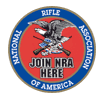
|

|
|
